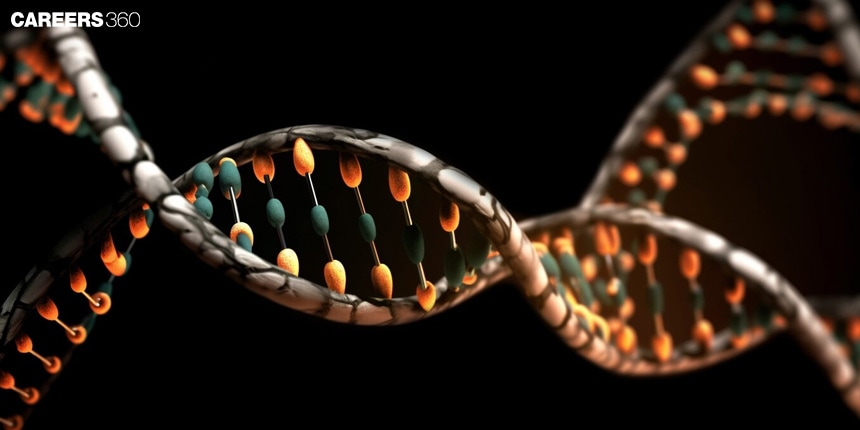Genetic Mutation: Definition, Steps, Types and Examples
Mutation refers to a change in the DNA sequence of an organism, and this change may occur through various means, either naturally or due to other factors. It defines mutation meaning which is basically, the mutation is the alteration of the genetic material, resulting in new traits or characters. Mutation in biology is, thus, the process where the genetic code is changed, which sometimes leads to a new version of a gene. Mutation definition in biology points out that mutations can result from factors like environment or mistakes in DNA replication. Some examples of mutations are colour differences or disease resistance.
Don't Miss: Most scoring concepts for NEET | NEET papers with solutions
NEET 2025: Syllabus | PYQs | Crack NEET in 2 months - Study Plan
NEET Important PYQ & Solutions: Physics | Chemistry | Biology | NEET PYQ's (2015-24)
- What Are Genetic Mutations?
- Classifications and Types of Mutations
- Causes Of Mutations
- Effects Of Mutations

What Are Genetic Mutations?
A nucleotide mutation, or change, in the DNA of an organism, which may be spontaneous or induced through environmental changes, refers to genetic mutations. Mutation meaning involves alterations in the genetic code, resulting in changes to traits or functions in an organism.
These mutations may cause alterations in characteristics, which are one of the very important factors for evolution since they introduce genetic diversity on which natural selection can act.
Also Read:
Classifications and Types of Mutations
In general, these can be classified based on the nature and extent of the change in genetic material.
Point Mutations: Point mutations include substitution, where one nucleotide is replaced by another where one or more nucleotides are added and deletion, where one or more nucleotides are removed from the DNA sequence.
Chromosomal Mutations: Chromosomal Mutation takes place at larger-scale changes. This includes deletion, by which a chunk of the chromosome is lost duplication, where part of a chunk is duplicated inversion, and where a section of a chromosome is bent in the wrong direction. Translocation, in which part of a chromosome is transferred from one chromosome to another.
Spontaneous Mutations: These arise as a result of natural factors, while induced mutations are a result of exogenous effects, such as chemicals or radiation.
Causes Of Mutations
Various environmental and biological factors may cause the mutations to occur.
Environmental Factors: Irradiation such as UV light, X-rays, and radioactive materials causes damage to the DNA hence causing mutations. Chemical compounds, such as benzene and asbestos, and some medications can also be known to cause mutations through genetic alteration.
Biological Factors: Biological factors are due to mistakes made when DNA replication occurs during cell division which leads to mutation. Viral infections occur whenever the virus infects a host and its genetic material is incorporated into the host's DNA thereby causing mutations. These mutations account for the overall genetic variation which drives evolution.
Effects Of Mutations
The effects of mutations will depend on their nature and location in the genome.
Beneficial Mutations
Selective Advantages: Some of the mutations give advantages to survival or reproductive capabilities.The classic example is resistance to antibiotics in bacteria. Some mutations might allow survival in the presence of antibiotics.
Deleterious Mutations
Genetic Disorders: Mutation can cause sickle cell anemia, and other severe disorders that cause poor health, such as cystic fibrosis.
Neutral Mutations
Silent Mutations: There would be no effect on the function of the protein. Such a mutation would seem to have very little or no effect at all on the organism.
Also Read
The video recommended on Genetic Mutation:
Frequently Asked Questions (FAQs)
Genetic mutation is a change in the nucleotide sequence of DNA that generally gives rise to variations in the structure and function of proteins. It means that a change in the DNA sequence can cause genetic disorders and variations.
These may be categorised into point and chromosomal: point mutations involve substitution, insertion, and deletion, while chromosomal mutations include deletion, duplication, inversion, and translocation.
The mutations are induced by environmental factors such as radiation and chemicals, biological ones like mistakes in the replication of DNA or viral insertions, and may even appear spontaneously.
They include neutral, harmful, or useful changes. They can result in evolutionary advantages, genetic disorders, or show no kind of effect.
Mutations can be detected by several techniques, which include PCR, gel electrophoresis, and DNA sequencing. The analyses and manipulations are made using bioinformatics tools and the new CRISPR technology.
Also Read
03 Dec'24 10:56 AM
30 Nov'24 08:28 PM
27 Nov'24 08:01 PM
26 Nov'24 11:40 PM
23 Nov'24 01:48 PM
21 Nov'24 05:41 PM
19 Nov'24 02:01 PM
19 Nov'24 11:02 AM
19 Nov'24 08:45 AM
18 Nov'24 10:54 PM